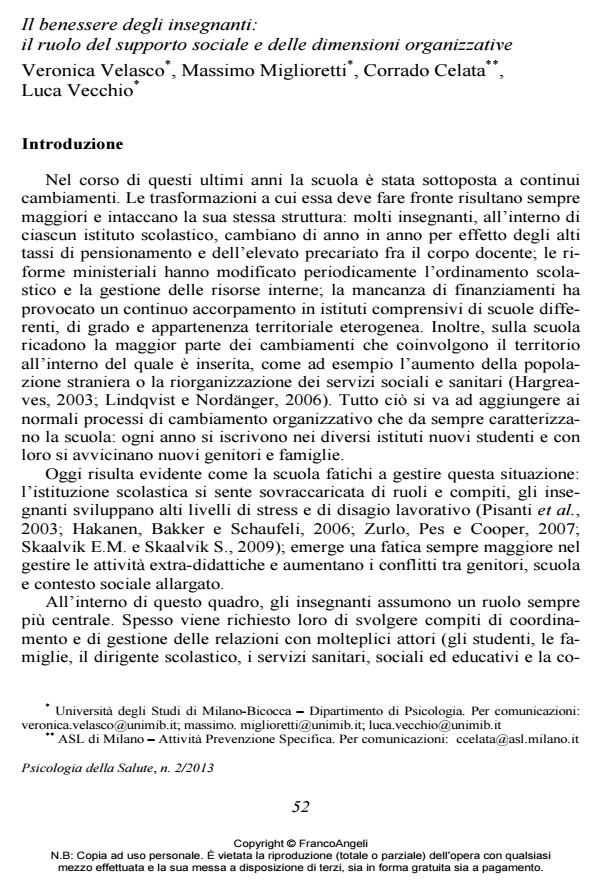Teachers’ well-being: the role of social support and organizational dimensions
Journal title PSICOLOGIA DELLA SALUTE
Author/s Veronica Velasco, Massimo Miglioretti, Corrado Celata, Luca Vecchio
Publishing Year 2013 Issue 2013/2
Language Italian Pages 19 P. 52-70 File size 401 KB
DOI 10.3280/PDS2013-002005
DOI is like a bar code for intellectual property: to have more infomation
click here
Below, you can see the article first page
If you want to buy this article in PDF format, you can do it, following the instructions to buy download credits

FrancoAngeli is member of Publishers International Linking Association, Inc (PILA), a not-for-profit association which run the CrossRef service enabling links to and from online scholarly content.
This study aims to investigate the relation between individual and organizational demands and resources and well-being in a group of teachers. 209 teachers (mean age = 47.49, 80% female) from 201 middle and high schools of the Lombardy Region were asked to complete a questionnaire on the socio-personal and school characteristics, like perception of working conditions like student discipline management, relationship to families, job overload, principal support and teamwork with other teachers; burnout, engagement and job satisfaction. A path analysis highlighted that two dimensions of burnout and engagement are strongly influenced by the quality of the relationship with the principal. Management of student disciplinary problems seems to weakly influence the levels of burnout or engagement. Moreover, support from the principal and family affected job satisfaction, mediated by burnout and engagement. Results underscore the need to care of teacherwell-being by means of an organizational approach that takes into account the individual and contextual resources, the relational aspects and the management of the school as an integrated system. Among these resources, the role of the principal seems to be particularly important.
Keywords: Secondary school teachers, well-being, work conditions, school principal
- Feeling Guilty or Not Guilty. Identifying Burnout Profiles among Italian Teachers Gloria Guidetti, Sara Viotti, Pedro R. Gil-Monte, Daniela Converso, in Current Psychology /2018 pp.769
DOI: 10.1007/s12144-016-9556-6 - Organizational Climate and Teachers’ Morale: Developing a Specific Tool for the School Context – A Research Project in Italy Daniela Converso, Michela Cortini, Gloria Guidetti, Giorgia Molinengo, Ilaria Sottimano, Sara Viotti, Barbara Loera, in Frontiers in Psychology 2132/2019
DOI: 10.3389/fpsyg.2019.02132 - Unmasking Reflexivity in HR Managers During the COVID-19 Lockdown in Italy Silvio Carlo Ripamonti, Laura Galuppo, Giulia Provasoli, Angelo Benozzo, in Frontiers in Psychology 588128/2020
DOI: 10.3389/fpsyg.2020.588128 - Teacher Satisfaction in Relationships With Students and Parents and Burnout Maria Luisa Pedditzi, Marcello Nonnis, Eraldo Francesco Nicotra, in Frontiers in Psychology 703130/2021
DOI: 10.3389/fpsyg.2021.703130 - A Qualitative Study on Representations of Intellectual and Relational Capital Among a Group of Managers in an Italian Trade-Union Silvio Carlo Ripamonti, Laura Galuppo, Sara Petrilli, Angelo Benozzo, in Frontiers in Psychology 641584/2021
DOI: 10.3389/fpsyg.2021.641584 - Multiple Health Behavior Programs in School Settings: Strategies to Promote Transfer-of-Learning Through Life Skills Education Veronica Velasco, Corrado Celata, Kenneth W. Griffin, in Frontiers in Public Health 716399/2021
DOI: 10.3389/fpubh.2021.716399
Veronica Velasco, Massimo Miglioretti, Corrado Celata, Luca Vecchio, Il benessere degli insegnanti: il ruolo del supporto sociale e delle dimensioni organizzative in "PSICOLOGIA DELLA SALUTE" 2/2013, pp 52-70, DOI: 10.3280/PDS2013-002005